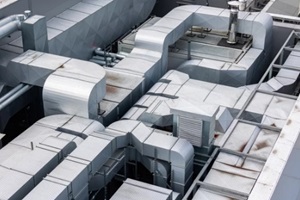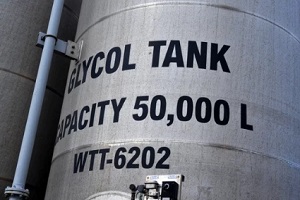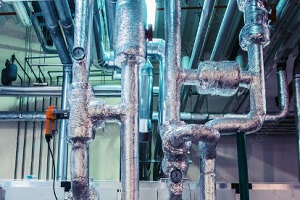 For building managers and property owners, managing a cooling system isn’t just about ensuring comfortable temperatures for occupants—it’s also about safety. During winter, a key component often used in HVAC systems is propylene glycol, a compound that aids in heat transfer and prevents freezing.
For building managers and property owners, managing a cooling system isn’t just about ensuring comfortable temperatures for occupants—it’s also about safety. During winter, a key component often used in HVAC systems is propylene glycol, a compound that aids in heat transfer and prevents freezing.
While propylene glycol provides essential benefits, it’s important to maintain the right concentrations. Improper propylene glycol levels can lead to reduced system efficiency, equipment damage, and health risks.
In this blog post, we’ll look at why propylene glycol levels change, and what issues can arise from neglecting maintenance.
Understanding Why Glycol Levels Change When Not Monitored
Propylene glycol levels in HVAC systems can fluctuate over time when not properly monitored. There are a few key reasons why glycol concentrations tend to change.
Dilution
Fresh water is often added to glycol systems during maintenance or repairs. This additional water dilutes the glycol concentration over time. Lower concentrations fall below optimal levels and reduce the effectiveness of the glycol solution.
Degradation
Propylene glycol is susceptible to degradation over time. Factors such as age, chemical contamination from pipeline scale or corrosion, excessive heat exposure, and bacterial growth can break down the chemical bonds in propylene glycol.
This degradation process reduces the ability of the solution to provide optimal freeze and corrosion protection, lowering the overall effectiveness in HVAC systems.
In addition to losing effectiveness as propylene glycol degrades, the chemical breakdown process also produces glycolic acid as a byproduct. Glycolic acid is an organic compound with acidic properties.
The formation of glycolic acid lowers the pH of the glycol solution, contributing to increased corrosion. If glycolic acid concentrations become too high from excessive glycol degradation, it can cause significant damage to metal pipes, fittings, and other HVAC components.
Leaks & Overflow
Glycol solutions can escape from HVAC systems through various means. Leaky pipes, valves, pumps and other components allow glycol to drip out over time. Overflow or spills when topping off glycol levels during maintenance also lead to direct loss of glycol.
Any of these modes of glycol loss, if excessive or unnoticed, reduce the overall level and concentration of the solution in the system. Even small leaks add up over time and should be addressed to maintain optimal glycol levels and prevent depletion.
What Glycol-Related Issues Can Arise From Neglecting Maintenance?
 Preventative maintenance, testing, and prompt top-offs or replacements help to ensure glycol levels are within specified ranges. Work with a professional water treatment company for these services.
Preventative maintenance, testing, and prompt top-offs or replacements help to ensure glycol levels are within specified ranges. Work with a professional water treatment company for these services.
Being proactive allows HVAC professionals to avoid the many issues that can arise from improper long-term glycol management. Regular maintenance can help avoid emergencies and in the long run extend the life of your system. Some examples of issues that can arise include:
Freezing
Glycol solution that becomes excessively diluted will see a decrease in its freezing point depression capacity. With lower concentrations, the glycol may no longer keep water from freezing at the lowest temperatures experienced by the HVAC system.
This lack of freeze protection can then allow ice crystals to form in pipes and equipment, leading to ruptures, cracks, and mechanical damage from expansion during freezing.
Corrosion
Glycol solution that has degraded or become diluted loses effectiveness at preventing corrosion. The reduced ability to form a protective layer allows metal pipes and components in the HVAC system to be exposed to more oxygen and ions that cause corrosion damage. This leads to pitting, rust formation, reduced structural integrity and leaks that can be very costly to repair.
Efficiency Loss
Glycol solution that is too diluted or too concentrated lowers the heat transfer efficiency in an HVAC system. The improper ratios hinder the ability of the solution to transfer heat energy effectively between the heating or cooling source and the air or water.
This decline in energy exchange performance leads to higher energy usage as the system struggles to maintain desired heating or cooling levels. Diligent glycol monitoring through testing and automated measurement allows concentrations to be maintained at optimum levels for maximizing heat transfer efficiency and controlling energy costs.
Determining The Correct Amount Of Propylene Glycol
 Reputable water treatment companies offer a variety of services to help maintain safe, efficient glycol systems. They provide comprehensive glycol testing to check key metrics like concentration percentage, freeze point, pH, and acid number. This testing identifies whether glycol levels have become diluted or degraded so that adjustments can be made.
Reputable water treatment companies offer a variety of services to help maintain safe, efficient glycol systems. They provide comprehensive glycol testing to check key metrics like concentration percentage, freeze point, pH, and acid number. This testing identifies whether glycol levels have become diluted or degraded so that adjustments can be made.
Full service water treatment professionals can also top-off low glycol levels as needed. In cases of severe degradation or contamination, full replacement and disposal services drain, flush and refill systems with new glycol to meet specifications. With routine service, water treatment companies take on monitoring and upkeep of glycol levels, allowing facility managers to focus on operations.
Your Partners In Peak Performance
Understanding the many intricacies and complexities of cooling systems requires skilled expertise, the right knowledge, proper vigilance, and a trusted partner by your side. Tower Water, evolving from its humble beginnings as a family-owned business, has massively expanded its reach, blending the scale of a regional company with the personal touch offered by family enterprises.
At Tower Water, we take pride in crafting solutions tailored to address your unique challenges. Our approach isn’t just about transactional services; it’s about forging long-lasting partnerships through consistently exceptional service and carefully targeted solutions.
Contact Tower Water today at 212.518.6475 or schedule a consultation online to explore our comprehensive water treatment services.
